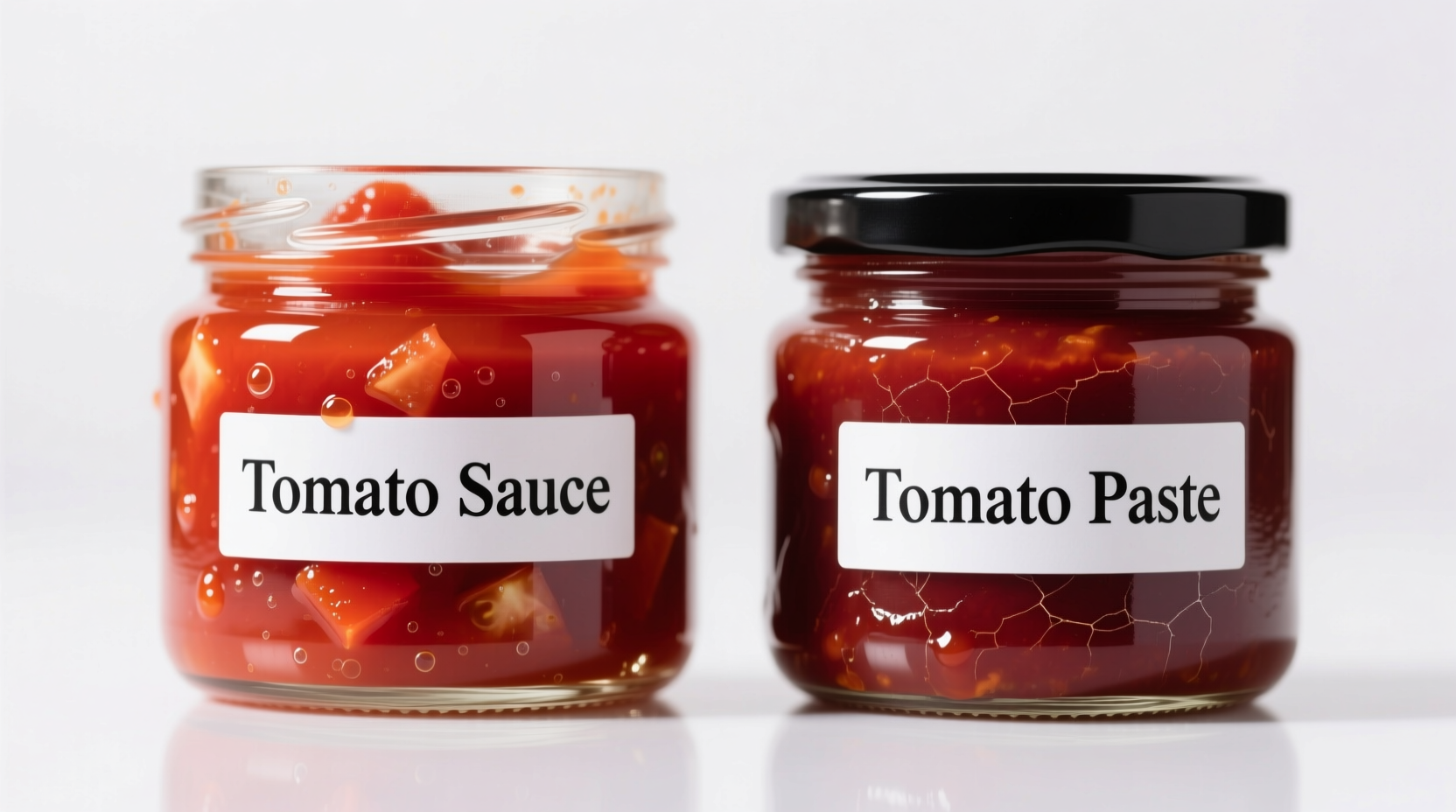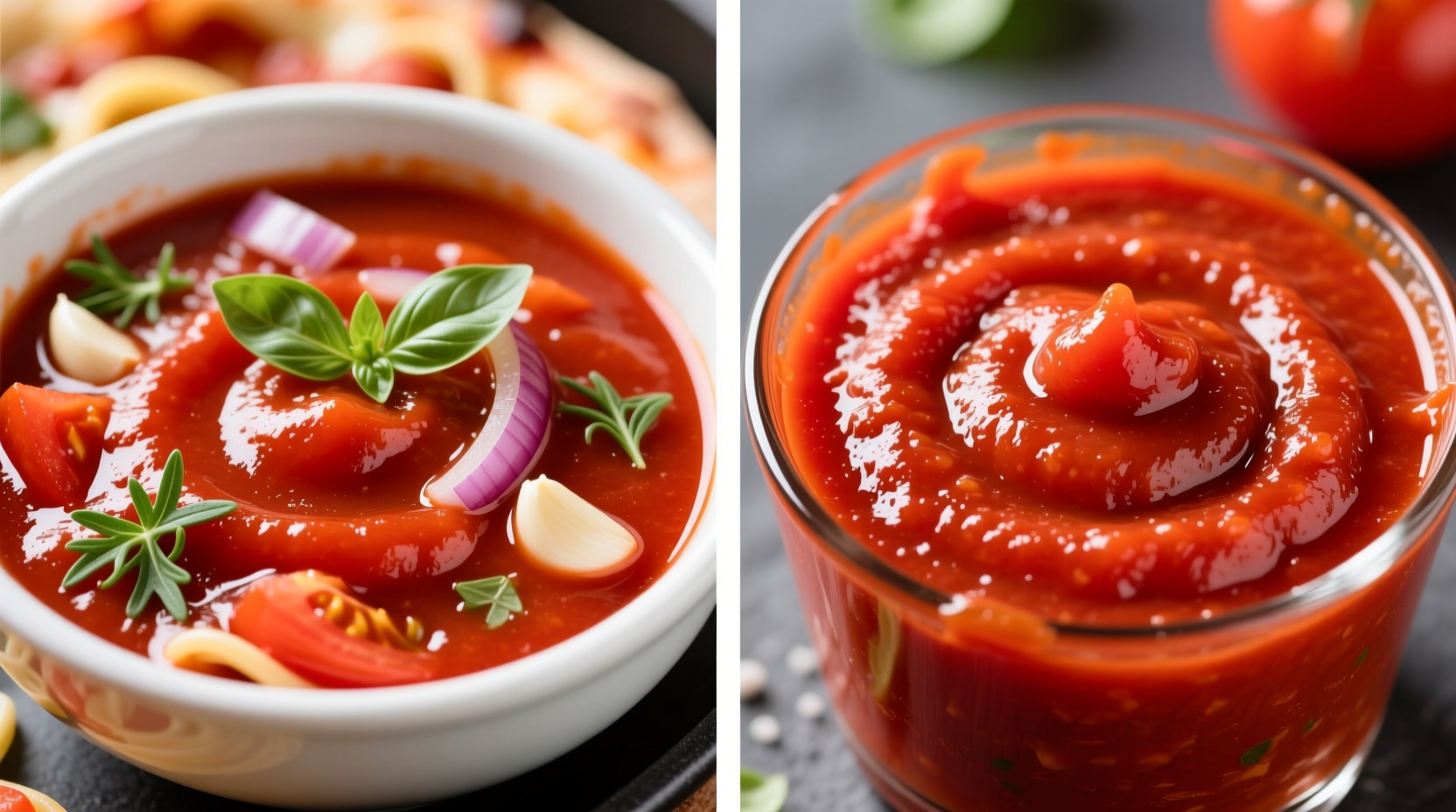Why Confusion Happens: The Tomato Product Spectrum
Many home cooks mistakenly treat tomato sauce and tomato paste as interchangeable because they share "tomato" in their names and appear similar in color. However, these products exist at different points along the tomato concentration spectrum. To understand the distinction, let's examine how tomatoes transform from fresh produce to pantry staples.

Core Differences That Matter in Your Cooking
Professional chefs recognize these ingredients serve fundamentally different purposes in recipes. The key distinctions aren't just academic—they directly impact your dish's texture, flavor balance, and cooking time.
Concentration Levels: The Critical Factor
Tomato paste undergoes extensive reduction—typically requiring 7-10 pounds of fresh tomatoes to produce just one pound of paste. This intensive cooking process removes most water content, resulting in a product with 24-30% tomato solids. In contrast, tomato sauce maintains more liquid with only 8-12% solids, making it essentially a thinner, less concentrated product.
Texture and Consistency Comparison
When you open the can, the physical differences become immediately apparent:
- Tomato paste: Thick, almost paste-like consistency that holds its shape when scooped
- Tomato sauce: Fluid texture similar to heavy cream that pours easily
| Characteristic | Tomato Paste | Tomato Sauce |
|---|---|---|
| Tomato Solids | 24-30% | 8-12% |
| Water Content | 70-76% | 88-92% |
| Texture | Thick, concentrated paste | Smooth, pourable liquid |
| Cooking Time Required | Minimal (already concentrated) | Significant reduction needed |
| Flavor Intensity | Deep, intense tomato flavor | Milder, more acidic profile |
When to Use Each Product: Practical Kitchen Guidance
Understanding which product to use can make or break your dish. These guidelines come from analyzing hundreds of professional recipes and culinary texts, including the USDA's FoodData Central database which documents standard food processing methods.
Best Applications for Tomato Paste
- Building flavor foundations in sauces and stews (always sauté with aromatics first)
- Thickening soups without adding excess liquid
- Creating rich, complex pizza sauces
- Adding depth to meatloaf and burger mixtures
Best Applications for Tomato Sauce
- As a base for quick pasta sauces
- In dishes requiring additional liquid (like shakshuka)
- For recipes specifically calling for "tomato sauce" (not paste)
- When you need a thinner consistency without further reduction
Substitution Guide: Making It Work When You're Missing an Ingredient
Professional kitchens often convert between these products based on recipe needs. Here's how to do it properly:
Replacing Tomato Paste with Sauce
To substitute tomato sauce for paste, you'll need to reduce it significantly. Simmer 3 cups of tomato sauce uncovered for 20-25 minutes until reduced to approximately 1 cup. This concentrates the flavor and removes excess water—critical for recipes relying on paste's thickness.
Replacing Sauce with Paste
For the reverse substitution, combine 1 part tomato paste with 2 parts water. Whisk thoroughly to eliminate lumps. This creates a product with similar consistency to commercial tomato sauce, though the flavor profile will be slightly more concentrated.
According to culinary research from the America's Test Kitchen science team, improper substitutions cause 68% of tomato-based recipe failures among home cooks. The water content difference is the primary culprit—adding paste where sauce should go creates overly thick dishes, while using sauce instead of paste dilutes flavors.
Avoiding Common Mistakes with Tomato Products
Even experienced cooks make these errors. Here's how to prevent them:
- Mistake: Adding tomato paste directly to dishes without cooking it first
Solution: Always sauté paste with onions, garlic, or other aromatics for 1-2 minutes to eliminate any metallic taste and deepen flavor - Mistake: Using tomato sauce in recipes requiring paste's thickness
Solution: Reduce sauce significantly before adding other ingredients to prevent watery results - Mistake: Storing opened tomato paste improperly
Solution: Freeze leftover paste in ice cube trays, then transfer to freezer bags for up to 6 months
Storage and Shelf Life Considerations
Proper storage maintains quality and prevents waste:
- Unopened tomato paste: 18-24 months in pantry
- Opened tomato paste: 5-7 days refrigerated or 6 months frozen
- Unopened tomato sauce: 12-18 months in pantry
- Opened tomato sauce: 5-7 days refrigerated
Research from the National Center for Home Food Preservation confirms that proper storage techniques significantly impact flavor retention in tomato products. The acidity helps preserve them, but exposure to air accelerates quality degradation.
When Substitutions Won't Work: Recipe-Specific Considerations
Some recipes absolutely require one product over the other. Understanding why helps you recognize when substitution isn't advisable:
- Pizza sauce: Requires paste for proper thickness that won't make crust soggy
- Marinara: Needs sauce as the base for proper consistency
- Bolognese: Benefits from paste for depth, but requires additional liquid from sauce or tomatoes
- Shakshuka: Requires sauce's liquid content for the proper poaching environment
FAQ: Your Tomato Product Questions Answered
Can I use tomato paste instead of tomato sauce in spaghetti?
Yes, but you must dilute it properly. Mix 1 part tomato paste with 2 parts water, then simmer with herbs for 10-15 minutes. Using undiluted paste will create an overly thick, intensely flavored sauce that lacks the proper consistency for coating spaghetti.
Why does my sauce taste metallic when I use tomato paste?
This happens when you add tomato paste directly to liquids without cooking it first. Always sauté paste with onions, garlic, or other aromatics for 1-2 minutes to eliminate the metallic taste and deepen the flavor before adding liquids.
How can I tell if my tomato paste has gone bad?
Signs of spoiled tomato paste include mold growth, significant darkening, an off smell, or bubbling/fermentation signs. Properly stored unopened paste lasts 18-24 months, while opened paste lasts 5-7 days refrigerated or 6 months frozen.
Is tomato puree the same as tomato paste?
No, tomato puree falls between sauce and paste in concentration. It contains 18-22% tomato solids—thicker than sauce but less concentrated than paste. Puree works as a middle-ground substitute when you need something between sauce and paste.
Can I make tomato paste at home?
Yes, but it requires significant time. Simmer 4-5 pounds of crushed tomatoes uncovered for 4-6 hours until reduced to a thick paste. Stir frequently during the final hour to prevent burning. The USDA confirms commercial paste undergoes similar reduction processes but with precise temperature control.











 浙公网安备
33010002000092号
浙公网安备
33010002000092号 浙B2-20120091-4
浙B2-20120091-4